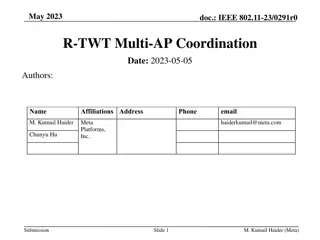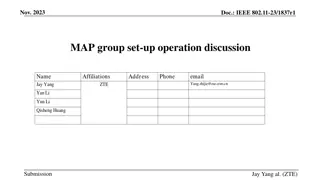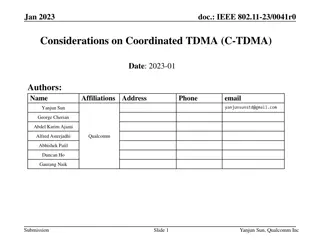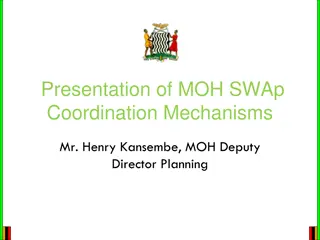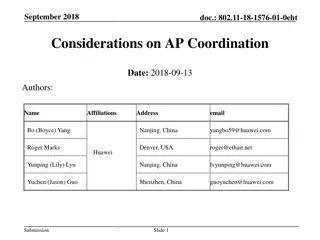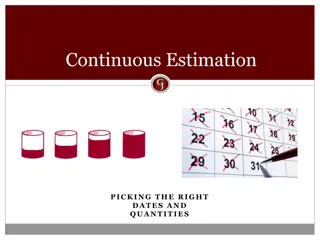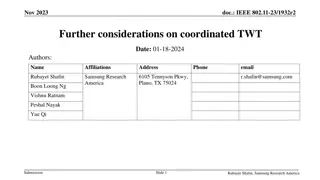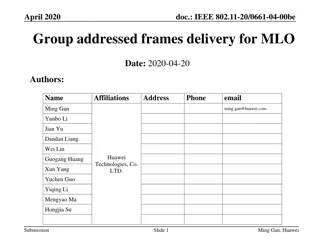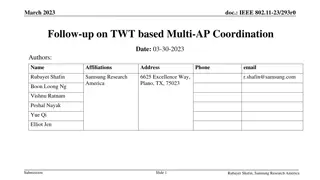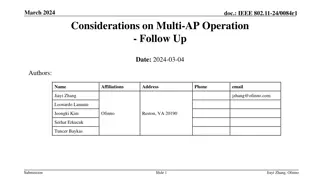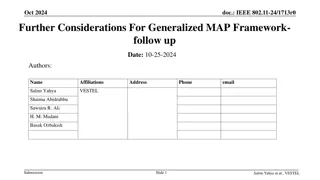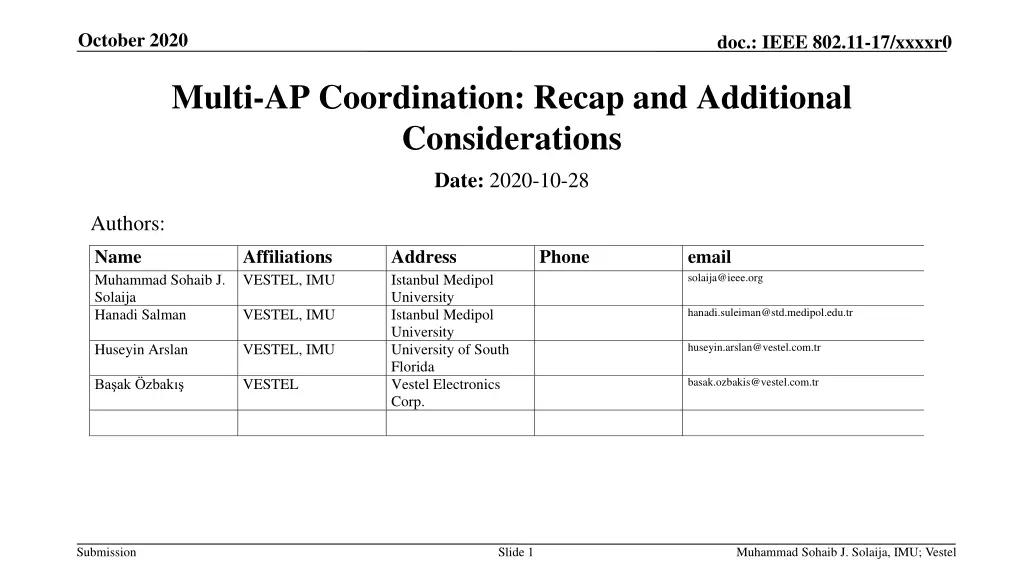
IEEE 802.11-17 Multi-AP Coordination Overview
"Explore the recap and additional considerations for multi-AP coordination in IEEE 802.11-17 standards. Learn about group formation, coordination schemes, data transmission procedures, and more to enhance wireless networking efficiency."
Download Presentation

Please find below an Image/Link to download the presentation.
The content on the website is provided AS IS for your information and personal use only. It may not be sold, licensed, or shared on other websites without obtaining consent from the author. If you encounter any issues during the download, it is possible that the publisher has removed the file from their server.
You are allowed to download the files provided on this website for personal or commercial use, subject to the condition that they are used lawfully. All files are the property of their respective owners.
The content on the website is provided AS IS for your information and personal use only. It may not be sold, licensed, or shared on other websites without obtaining consent from the author.
E N D
Presentation Transcript
October 2020 doc.: IEEE 802.11-17/xxxxr0 Multi-AP Coordination: Recap and Additional Considerations Date: 2020-10-28 Authors: Name Muhammad Sohaib J. Solaija Hanadi Salman Affiliations VESTEL, IMU Address Istanbul Medipol University Istanbul Medipol University University of South Florida Vestel Electronics Corp. Phone email solaija@ieee.org hanadi.suleiman@std.medipol.edu.tr VESTEL, IMU huseyin.arslan@vestel.com.tr Huseyin Arslan VESTEL, IMU basak.ozbakis@vestel.com.tr Ba ak zbak VESTEL Submission Slide 1 Muhammad Sohaib J. Solaija, IMU; Vestel
October 2020 doc.: IEEE 802.11-17/xxxxr0 Abstract This contribution recaps the various topics discussed for multi-AP coordination before going on to highlight some concerns regarding incorporation of multi- link devices/operation in the coordination process. Moreover, a general (high- level) process for group formation and coordination scheme selection is also discussed. Submission Slide 2 Muhammad Sohaib J. Solaija, IMU; Vestel
October 2020 doc.: IEEE 802.11-17/xxxxr0 Multi-AP Coordination Revisited (1/6) Topic Ref Key Contribution Candidate/operation sets along with are roles (sharing/shared, coordinator/coordinated APs) are defined, and stages of multi-AP operation procedures (setup, coordination, transmission) are discussed. Basic definition, setup, and transmission procedure [1] A method is described where AP establishes link with its neighboring AP to acquire information about STA. [2] [3] STA-triggered synchronous multi-AP transmission is proposed. Correspondingly master and slave AP terminologies are suggested [4] A unified transmission procedure is presented. A (slave) trigger frame is proposed to provide synchronization and resource allocation [5] The multi-AP procedure is divided into sounding, selection and transmission stages. Regarding the selection process, buffer state and bandwidth can be helpful in resource allocation. [6] General transmission procedure is discussed with emphasis on flexibility Submission Slide 3 Muhammad Sohaib J. Solaija, IMU; Vestel
October 2020 doc.: IEEE 802.11-17/xxxxr0 Multi-AP Coordination Revisited (2/6) Topic Ref Key Contribution Data transmission (after successful sounding) is considered. Procedure of multi-AP selection is discussed where the M-AP sends a selection frame to selected APs and the selected S-APs respond to it. If a S-AP is unable to respond, the M-AP selects other S- AP(s). The multi-AP architecture is discussed considering the multi-AP set with/without anchor, data and control channel interfaces for inter-AP communication, backhaul options (dedicated or not). Two-level BSS is discussed where the STA only switches from member BSS (no coordinated transmission) to virtual BSS (using coordinated transmission) when link quality degrades beyond a threshold. 802.11r is used as a reference. Infrastructure BSS with a group of APs coordinated by V- BSS coordinator is described. Can enable single association and authentication state maintenance. Operation [7] [8] Virtual BSS [9] [10] Submission Slide 4 Muhammad Sohaib J. Solaija, IMU; Vestel
October 2020 doc.: IEEE 802.11-17/xxxxr0 Multi-AP Coordination Revisited (3/6) Topic Ref Key Contribution Sequential sounding with explicit CSI feedback is discussed. Sounding [11] Code-based multi-AP joint sounding is proposed, and some initial simulation results are provided comparing code-based approach with sequential sounding. [12] [13] Performance of code-based joint sounding (all APs send the NDPA and NDP simultaneously) is shown via simulation. Code-based method is better than tone selection in low SNR region. Implicit sounding is discussed. Centralized & sequential approaches are proposed. [14] [15] For MU-MIMO implicit sounding might not provide good enough quality. Therefore, joint explicit sounding is proposed as an option for 802.11be. [16] A method for selective feedback of BFR by STA(s) is discussed. Only if the channel quality between STA and AP is good does the STA feedback BFR to the AP. Synchronized and independent NDP transmissions are considered for JT and CBF, respectively. [17] Submission Slide 5 Muhammad Sohaib J. Solaija, IMU; Vestel
October 2020 doc.: IEEE 802.11-17/xxxxr0 Multi-AP Coordination Revisited (4/6) Topic Ref Key Contribution Concept of static and dynamic groups is presented where the latter is a subset of the former. Furthermore, the STA(s) may recommend the candidate APs. A relatively manageable environment (enterprise/factory) seems a practical scenario. Metric-based and dynamic coordinator AP selection approaches are discouraged due to associated overhead. Should it be defined in the standard or left to implementation? Candidate set is defined according to boundary of trust. Multiple APs may be capable of acting as a sharing AP within the candidate set. Group formation [18] [19] [20] [21] Boundary of coordination functions is discussed. Some cases where you would NOT want the APs to coordinate with each other (similar to SRG group defined in 11ax). Authentication of MAP trigger frames is highlighted. All or some selected APs may be able to initiate/trigger coordination Submission Slide 6 Muhammad Sohaib J. Solaija, IMU; Vestel
October 2020 doc.: IEEE 802.11-17/xxxxr0 Multi-AP Coordination Revisited (5/6) Topic Ref Key Contribution OTA synchronization is proposed between APs to announce upcoming transmissions. Frist, the announced SR frame describes the transmission with Tx power constraints, TXOP information and UL/DL nature, followed by transmission of APs to their respective STAs. At the end, the STAs respond with their acknowledgment. Transmitter nulling/ZF and scheduling at each AP is considered with MMSE receivers. Results show CBF provides significant gains as compared to single AP and CSR. Schemes [22] [23] Results show that using Co-OFDMA with higher probability does not provide much performance gain regarding burst throughput and latency, conversely, using co-OFDMA with lower probability is better. Unicast, broadcast and multi-cast approaches for data sharing are considered for JT over wireless links. [24] Data Sharing and Backhaul [25] Impact of backhaul rate and discussion of in-channel vs. off-channel backhaul are provided. The backhaul rate needs to be much higher than RMU to avoid degradation of effective throughput. [26] Submission Slide 7 Muhammad Sohaib J. Solaija, IMU; Vestel
October 2020 doc.: IEEE 802.11-17/xxxxr0 Multi-AP Coordination Revisited (6/6) Topic Ref Key Contribution Unified reference model to support both ML and MAP features is discussed. The authors propose grouping of AP MLD instances into forming an AP MLD group. Expansion of multi-link to multi-AP for stability and the different between single-AP multi-link and multi-AP multi-link is highlighted. Authors argue that multi-AP provides a more stable link capacity. Moreover, in the multi-AP multi-link case the MAC entities on APs cannot be directly coordinated as in the single-AP multi-link case. MLO [27] [28] Submission Slide 8 Muhammad Sohaib J. Solaija, IMU; Vestel
October 2020 doc.: IEEE 802.11-17/xxxxr0 Group Formation Receive channel characteristic(s) Obtain characteristics of different links between STAs and APs Distance, SINR, RSRP, RSSI Depending upon the obtained characteristics, determine candidate APs for coordination Per-user based, network-based Verify if the selected APs can fulfil the coordination requirement Min SINR, Rx Power, etc. If yes, this is the coordination group/cluster Determine candidate group(s) No O Coordination requirement met? Yes Select group(s) Control coordinated communication Submission Slide 9 Muhammad Sohaib J. Solaija, IMU; Vestel
October 2020 doc.: IEEE 802.11-17/xxxxr0 Coordination Scheme Selection Check STA requirments (throughout, latency, jitter...) Check user requirements AC or UP information can be used Obtain characteristics of different links between STAs and APs Distance, SINR, RSRP, RSSI Evaluate performance of coordination scheme Check feasibility Backhaul bandwidth, latency, etc. If satisfied, proceed with coordinated transmission Check link quality between different APs and STAs Evaluate performance of coordination scheme(s) User requirements met? Check feasibility of coordination scheme Proceed with coordinated transmission Submission Slide 10 Muhammad Sohaib J. Solaija, IMU; Vestel
October 2020 doc.: IEEE 802.11-17/xxxxr0 Multi-link Operation Multi-link and/or multi-band operation 2.4, 5 and 6 GHz bands may be used simultaneously by some devices. Potential difference in coverage areas for multi-band operation. For MLDs, it might be challenging to coordinate over multiple bands Backhaul usage for different bands/links Submission Slide 11 Muhammad Sohaib J. Solaija, IMU; Vestel
October 2020 doc.: IEEE 802.11-17/xxxxr0 Multi-link Operation Multi-link (Information) Element [29] Advertising multi-link capabilities and information of other STA(s) of MLD Can be used in the context of discovery Can be included in the probe response frame Can be used for (re)association response frame A STA of an MLD may provide complete or partial information of another STA of its MLD in the per-STA profile sub-element of the Multi-Link element that it transmits An AP of an AP MLD shall include complete profile of another AP of its MLD in its (re)association response frame A STA of a non-AP MLD shall include complete profile of another STA of its MLD in its (re)association request frame Submission Slide 12 Muhammad Sohaib J. Solaija, IMU; Vestel
October 2020 doc.: IEEE 802.11-17/xxxxr0 Multi-link Operation Multi-AP (Information) Element? How to advertise the multi-AP capabilities of different APs? An information element similar to ML element? Can ML element carry this additional information? Unnecessary overhead for MLDs that are not coordinating? Submission Slide 13 Muhammad Sohaib J. Solaija, IMU; Vestel
Month Year doc.: IEEE 802.11-17/xxxxr0 Straw Poll # 1 Should the group formation process and its underlying steps be defined in the standard or left to implementation? a) Yes b) No c) Abstain Submission Slide 14 John Doe, Some Company
Month Year doc.: IEEE 802.11-17/xxxxr0 Straw Poll # 2 Should the coordination scheme selection process and its underlying steps be defined in the standard or left to implementation? a) Yes b) No c) Abstain Submission Slide 15 John Doe, Some Company
Month Year doc.: IEEE 802.11-17/xxxxr0 Straw Poll # 3 Which of the following should be considered for advertising/sharing the coordination capabilities of APs: a) Modifying multi-link element to contain the multi-AP coordination capabilities? b) Designing a different information element/container to advertise coordination capabilities? c) Something else Submission Slide 16 John Doe, Some Company
October 2020 doc.: IEEE 802.11-17/xxxxr0 References 1. 2. 3. 4. 5. 6. 7. 8. 9. 10. Virtual BSS for Multi-AP Coordination Follow-Up, IEEE 802.11-19/ 11. Channel Sounding for Multi-AP CBF, IEEE 802.11-20/123r2 Multi-AP Operation - Basic Definition, IEEE802.11-20/0617r3 Setup for Multi-AP coordination, IEEE802.11-19/1895r2 Multi-AP Transmission procedure, IEEE802.11-19/1652r1 A Unified Transmission Procedure for Multi-AP Coordination, IEEE 802.11-19/1102r0 Multi-AP Transmission Procedure, IEEE 802.11-19/0804r0 Consideration on Multi-AP Coordination, IEEE 802.11-19/1129r2 Efficient Operation for Multi-AP Coordination, IEEE 802.11-19/1143r3 Overview of Multi-AP Operation in 11be, IEEE 802.11-20/0064r1 Operation of Virtual BSS Architecture for Multi-AP Coordination, IEEE 802.11-19/1972r1 Submission Slide 17 Muhammad Sohaib J. Solaija, IMU; Vestel
October 2020 doc.: IEEE 802.11-17/xxxxr0 References 12. Multi-AP Sounding Discussion, IEEE 802.11-20/0052r0 13. Multi-AP Sounding Discussion Follow Up, IEEE 802.11-20/0502r0 14. Multi-AP Implicit Channel Sounding, IEEE 802.11-20/0089r1 15. Joint Sounding for Multi-AP Systems, IEEE 802.11-19/1593r3 16. One Channel Information Feedback Method for Multi-AP Coordination, IEEE 802.11- 19/1573r0 17. Consideration of Multi-AP Sounding, IEEE 802.11-19/1134r1 18. Multi-AP Group Establishment, IEEE 802.11-19/1961r4 19. Multi-AP Group Formation, IEEE 802.11-19/1616r1 20. AP Candidate Set Follow Up, IEEE 802.11-20/0596r1 21. Multi-AP Group Formation Follow-up, IEEE 802.11-19/1931r2 22. Multi-AP Coordination for Spatial Reuse, IEEE 802.11-20/0107r1 Submission Slide 18 Muhammad Sohaib J. Solaija, IMU; Vestel
October 2020 doc.: IEEE 802.11-17/xxxxr0 References 23. Multi-AP Collaborative BF in IEEE 802.11, IEEE 802.11-19/0772r1 24. Simulation Results for Coordinated OFDMA in Multi-AP Operation, IEEE 802.11-19-1592r0 25. Data Sharing for Multi-AP Coordination, IEEE 802.11-19/1554r1 26. Multi-AP Backhaul Analysis, IEEE 802.11-19/1588r0 27. Multi-link and Multi-AP Reference Model Discussion, IEEE 802.11-20/0068r0 28. Discussion on Expansion of Multi-Link Aggregation to Multi-AP, IEEE 802.11-20/0035r0 29. Amendment 8: Enhancements for Extremely High Throughput (EHT), IEEE P802.11beTM/D0.1 Submission Slide 19 Muhammad Sohaib J. Solaija, IMU; Vestel

